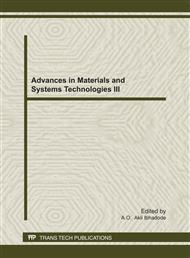p.495
p.501
p.507
p.517
p.525
p.537
p.547
p.555
p.561
Determination of Operational Parameters of a Single Cylinder Two Stroke Engine Run on Jatropha Biodiesel
Abstract:
The utilization of jatropha oil in a small capacity laboratory diesel engine was investigated. The Jatropha biodiesel was obtained from National Research Institute for Chemical Technology, Zaria - Nigeria. The biodiesel was within the EN, BIS and Brazil specification for biodiesel. The tested blends were 20/80%, 30/70%, 40/60% and 50/50%. Each blend was tested on a short term trial of one hour. 20/80% jatropha oil/diesel blend addition gave the maximum brake power and thermal efficiency. The exhaust gas temperatures of the jatropha oil/diesel blends were lower than that of diesel signifying lower heat loss. The percentage heat losses were lower when operated on higher jatropha oil/diesel blends. For economy of fuel, 20/80% gave specific fuel consumption values when compared to other jatropha oil/diesel blends at all engine speeds. Higher volumetric efficiencies were obtained for lower engine speeds of jatropha oil/diesel blends. Air/fuel ratio shows a decreasing trend with increase in jatropha oil content in jatropha oil/diesel blends. There was no reaction of the jatropha oil/diesel blends with engine parts as there was no engine starting problems, wear out of components or breakdown. No long term assessment, emission characteristics or endurance tests including breakdown of jatropha oil biodiesel were carried out. The research found that 20/80% blend of jatropha oil/diesel blend gave the best performance amongst all blends It is recommended that 20/80% jatropha oil/diesel blend should be used to supplement fossil fuel.
Info:
Periodical:
Pages:
525-536
Citation:
Online since:
October 2011
Authors:
Keywords:
Price:
Сopyright:
© 2012 Trans Tech Publications Ltd. All Rights Reserved
Share:
Citation:


